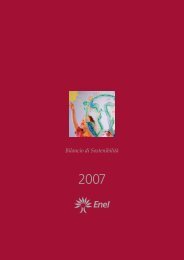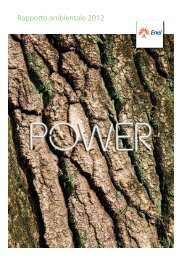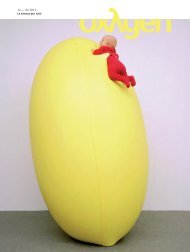Annual Report 2010 - Enel.com
Annual Report 2010 - Enel.com
Annual Report 2010 - Enel.com
You also want an ePaper? Increase the reach of your titles
YUMPU automatically turns print PDFs into web optimized ePapers that Google loves.
Investment property<br />
Investment property consists of the Group’s real estate<br />
held to generate rental in<strong>com</strong>e or capital gains rather than<br />
for use in operations or the delivery of goods and services.<br />
Investment property is initially recognized at cost in the<br />
same manner as other property, plant and equipment.<br />
Subsequently, it is measured at cost net of depreciation<br />
and any impairment losses. Impairment losses are determined<br />
on the basis of the following criteria.<br />
The fair value of investment property is determined on the<br />
basis of the state of the individual assets, projecting the<br />
valuations for the previous year in relation to the performance<br />
of the real estate market and estimated developments<br />
in the value of the assets. The fair value of investment<br />
property recognized at December 31, <strong>2010</strong> is equal<br />
to €365 million.<br />
Intangible assets<br />
Intangible assets are measured at purchase or internal development<br />
cost, when it is probable that the use of such<br />
assets will generate future economic benefits and the related<br />
cost can be reliably determined.<br />
The cost includes any directly attributable incidental expenses<br />
necessary to make the assets ready for use. The<br />
assets, with a definite useful life, are reported net of accumulated<br />
amortization and any impairment losses, determined<br />
as set out below.<br />
Amortization is calculated on a straight-line basis over the<br />
item’s estimated useful life, which is checked at least annually;<br />
any changes in amortization policies are reflected<br />
on a prospective basis.<br />
Amortization <strong>com</strong>mences when the asset is ready for use.<br />
Intangible assets with an indefinite useful life are not amortized<br />
systematically. Instead, they undergo impairment<br />
testing at least annually.<br />
Goodwill deriving from the acquisition of subsidiaries, associated<br />
<strong>com</strong>panies or joint ventures is allocated to each<br />
of the cash-generating units identified. After initial recognition,<br />
goodwill is not amortized but is tested for recoverability<br />
at least annually using the criteria described in the<br />
notes. Goodwill relating to equity investments in associates<br />
is included in their carrying amount.<br />
Impairment losses<br />
160 <strong>Enel</strong> <strong>Annual</strong> <strong>Report</strong> <strong>2010</strong> Consolidated financial statements<br />
Property, plant and equipment, property investment and<br />
intangible assets are reviewed at least once a year to determine<br />
whether there is evidence of impairment. If such<br />
evidence exists, the recoverable amount of any property,<br />
plant and equipment and intangible assets is estimated.<br />
The recoverable amount of goodwill and intangible assets<br />
with an indefinite useful life as well as that of intangible<br />
assets not yet available for use, is estimated annually.<br />
The recoverable amount is the higher of an asset’s fair<br />
value less costs to sell and its value in use.<br />
Value in use is determined by discounting estimated future<br />
cash flows using a pre-tax discount rate that reflects<br />
the current market assessment of the time value of money<br />
and the specific risks of the asset. The recoverable amount<br />
of assets that do not generate independent cash flows is<br />
determined based on the cash-generating unit to which<br />
the asset belongs.<br />
An impairment loss is recognized in the in<strong>com</strong>e statement<br />
if an asset’s carrying amount or that of the cash-generating<br />
unit to which it is allocated is higher than its recoverable<br />
amount.<br />
Impairment losses of cash generating units are first<br />
charged against the carrying amount of any goodwill attributed<br />
to it and then against the value of other assets, in<br />
proportion to their carrying amount.<br />
Impairment losses are reversed if the impairment has<br />
been reduced or is no longer present or there has been a<br />
change in the assumptions used to determine the recoverable<br />
amount.<br />
The recoverable amount of goodwill and intangible assets<br />
with an indefinite useful life as well as that of intangible<br />
assets not yet available for use is tested for recoverability<br />
annually or more frequently if there is evidence suggesting<br />
that the assets may be impaired. The original value of<br />
goodwill is not restored even if in subsequent years the<br />
reasons for the impairment no longer obtain.<br />
Inventories<br />
Inventories are measured at the lower of cost and net estimated<br />
realizable value except for those involved in trading<br />
activities, which are measured at fair value with recognition<br />
through profit or loss. Average weighted cost is used, which<br />
includes related ancillary charges. Net estimated realizable<br />
value is the estimated normal selling price net of estimated<br />
selling costs or, where applicable, replacement cost.









